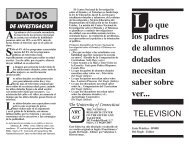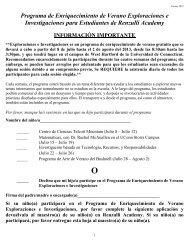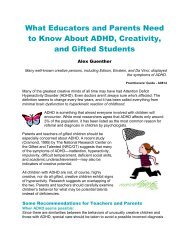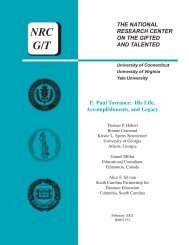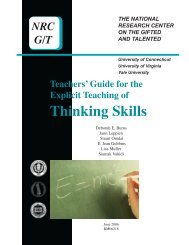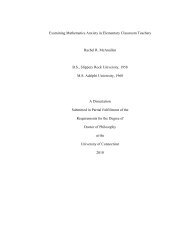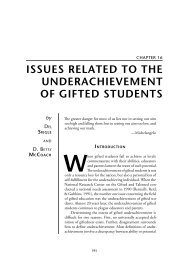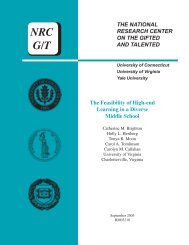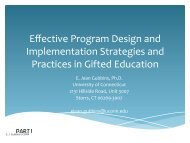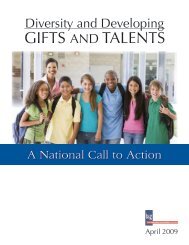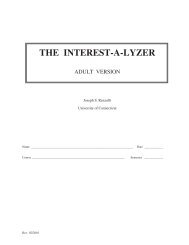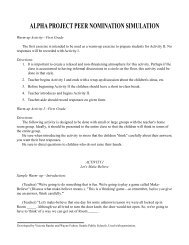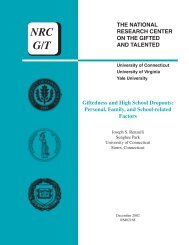Operation Houndstooth Intervention Theory - Neag Center for Gifted ...
Operation Houndstooth Intervention Theory - Neag Center for Gifted ...
Operation Houndstooth Intervention Theory - Neag Center for Gifted ...
- No tags were found...
You also want an ePaper? Increase the reach of your titles
YUMPU automatically turns print PDFs into web optimized ePapers that Google loves.
Interventio<strong>Operation</strong> HSocialCapitalin Today’sSchools14 winter 2006 • vol 29, no 1
oundstoothn <strong>Theory</strong>:by Joseph S. Renzulli,RJennifer er L. KoehlerKoehler,and Elizabeth h A. A. FogFogartyVision without action is merely a dream. Actionwithout vision just passes time. Vision with actioncan change the world!—Robert Barker (1993)After repeatedly observing the little boy crying on theschool bus, Melanie, a fifth grader, took a seat next tohim and struck up a conversation. “You don’t understand,”said Tony, a first grader whose face was practically hiddenbehind the thickest eyeglasses Melanie had ever seen. “You seethese glasses? I’m partially sighted. The kids trip me and make funof me. I have special books <strong>for</strong> my subjects, but there are no booksin the library that I can read.”Later that day, Melanie approached her enrichment teacherand asked if she could make Tony her Type III Project <strong>for</strong> the yeargifted child today 15
<strong>Operation</strong> Houndsooth <strong>Intervention</strong> <strong>Theory</strong>: Social Capital in Today’s Schools(Renzulli, 1976). Over the next severaldays, Melanie and the enrichmentteacher drew up a plan thatbegan with some “friendly persuasion”<strong>for</strong> the boys who were harassingTony. A few of the school’s bigger,well-respected boys and girls escortedTony from the school bus and satwith him in the lunchroom.Melanie then asked Tony a seriesof questions from an instrumentcalled the Interest-A-Lyzer (Renzulli,1997) to determine what some of hisreading interests might be. Sherecruited a number of the school’sbest writers to work on large-print“big books” that dealt with Tony’sinterests in sports and adventure stories.She also recruited the school’sbest artists to illustrate the books andserved as the editor and productionmanager <strong>for</strong> the series.As the project progressed over thenext several months, a remarkablechange took place in Tony’s attitudetoward school. He became a localcelebrity, and other students evensigned out books from Tony’s specialsection of the library. Melanie’s creativeidea and her task commitmentresulted in the development of profoundempathy and sensitivity tohuman concerns among a number ofchildren and at the same time allowedher to apply her talents to anunselfish cause. When questionedabout her work, Melanie explainedsimply, “It didn’t change the world,but it changed the world of one littleboy.”Melanie devoted her time andenergy to a socially responsible projectthat would improve the life of alittle boy. She saw a real-life problemand decided to discover and implementa solution. Melanie dedicatedher time to a cause that would bringher no personal gain other than thesatisfaction of helping a person inneed. However, Melanie did not dothis alone. She was enabled and supportedby her teacher and by herschool. She was aware that her educationalcommunity would be supportiveof her using a portion of herschool days to pursue this project andthat a variety of resources would bemade available to her. The point isnot whether or not Melanie couldhave completed this project on herown, the point is that she did not haveto do so. Now, imagine a school withoutany children like Melanie, orwithout any programs that allow childrento develop and carry out ideas tomake the world a better place. IfMelanie had gone to such a school,the other children would still bemocking Tony, and he would still bethe sad young student on the bus.A Brief Look at Education<strong>for</strong> AffectiveDevelopment in AmericaSocrates once asked, “Can virtuebe taught?” Among today’s educationalexperts there is general agreementthat virtues can be learned.American school policy makers continueto debate which values shouldbe taught and disagree widely on thebest way to teach them.Since colonial times, affective, orcharacter development as it has frequentlybeen referred to, has been afacet of American school learning.John Dewey’s early influence on theAmerican education system providedsome of the philosophical basis <strong>for</strong>character education in today’sschools. It was Dewey’s belief that“. . . moral education in school ispractically hopeless when we set upthe development of character as itssupreme end” (Dewey, 1916, p. 354).Instead, Dewey believed that charactereducation should enable studentsto learn how to act, so that in any situationthey will behave morally.Research conducted by Hartshorneand May in the 1930s supportedDewey’s aversion to the direct teachingof character education and foundthat participation in character educationin school had little effect onmoral conduct (Leming, 1993). Morerecent research has found a greatercorrelation between character educationparticipation and moral conduct(Rushton, Brainerd, & Pressley,1983; Wynne, 1989).Kohlberg’s cognitive-developmentaltheory provides a frameworkof the moral development processfrom birth through adulthood(Kohlberg & Turiel, 1971). A seriesof six stages organized into three levelsprovide a sequence through whichmorality is developed. During progressionthrough the preconventionallevel, one learns the consequences ofone’s own actions. Rules and fairnessgovern actions. Development in theconventional level removes the focusfrom oneself to an emphasis on one’splace in society. Duties and socialorder govern actions as the individuallearns the importance of having societalnorms. The postconventionallevel of development marks a periodin which the individual no longeraccepts the imposition of law andestablishes an ethical relativism <strong>for</strong>any given situation. In the 1970s,Lawrence Kohlberg (1975) connectedhis cognitive-developmental theory ofmoral reasoning to character educationprogramming in schools.<strong>Operation</strong> <strong>Houndstooth</strong>One of the more <strong>for</strong>tunate directionsin the social sciences in recentyears has been the development of the16 winter 2006 • vol 29, no 1
<strong>Operation</strong> Houndsooth <strong>Intervention</strong> <strong>Theory</strong>: Social Capital in Today’s Schoolsthe belief that the future holdsgood outcomes. Optimism maybe thought of as an attitude associatedwith expectations of afuture that is socially desirable, tothe individual’s advantage, or tothe advantage of others. It ischaracterized by a sense of hopeand a willingness to accept hardwork.• Courage. Courage is the ability toface difficulty or danger whileovercoming physical, psychological,or moral fears. Integrity andstrength of character are typicalmanifestations of courage, andthey represent the most salientmarks of those creative peoplewho actually increase social capital.• Romance with a topic or discipline.When an individual is passionateabout a topic or discipline, a trueromance, characterized by powerfulemotions and desires, evolves.The passion of this romanceoften becomes an image of thefuture in young people and providesthe motivation <strong>for</strong> a longtermcommitment to a course ofaction.• Sensitivity to human concerns.This trait encompasses the abilitiesto comprehend another’saffective world and to accuratelyand sensitively communicatesuch understanding throughaction. Altruism and empathy,aspects of which are evidentthroughout human development,characterize this trait.• Physical/mental energy. All peoplehave this trait in varying degrees,but the amount of energy anindividual is willing and able toinvest in the achievement of agoal is a crucial issue in high levelsof accomplishment. In thecase of eminent individuals, thisenergy investment is a major contributorto task commitment.Charisma and curiosity are frequentcorrelates of high physicaland mental energy.• Vision/sense of destiny. Complexand difficult to define, vision or asense of destiny may be describedbest by a variety of interrelatedconcepts, such as internal locusof control, motivation, volition,and self-efficacy. When an individualhas a vision or sense ofdestiny about future activities,events, and involvements, thatvision serves to stimulate planningand to direct behavior; itbecomes an incentive <strong>for</strong> presentbehavior.Of course, many interactionstake place between and among thesesix components. We will refer tothese components as co-cognitive factorsbecause they interact with andenhance the cognitive traits that weordinarily associate with success inschool and with the overall developmentof human abilities. The literaturereviewing the empirical researchthat resulted in the identification ofthese components can be found byvisiting our Web site (http://www.gifted.uconn.edu). The first phase ofour research included clarifying definitionsand identifying, adapting,and constructing assessment proceduresthat have extended our understandingof the components, especiallyas they are exhibited by youngpeople.A major assumption underlyingthis project is that all the componentsdefined in our background researchare subject to modification. Thus, thesecond phase of the project consists ofa series of experimental studies todetermine how various school-relatedinterventions can promote the typesof behavior associated with each ofthe components. These interventionsdraw upon existing and newly developedtechniques that can be usedwithin various school and extracurricularcontexts.<strong>Houndstooth</strong><strong>Intervention</strong> <strong>Theory</strong>Our examination of co-cognitivefactors that influence the developmentof abilities, creativity, and taskcommitment parallels a great deal oftheory and research that has looked atother noncognitive concerns such associal and emotional development,the development of self-concept andself-efficacy, character development,and the development of attitudes andvalues. Untold numbers of studieshave examined the effects of variousprogrammatic approaches that influencethese types of development inpersons who have experienced a rangeof adjustment problems and withinthe contexts of promoting positive,beneficial adjustment in healthy individualsand groups. Such approachesinclude a wide range of therapies,individual and group counselingtechniques, social and psychologicalexperimental treatments, and a broadarray of educational interventions.Because the focus of <strong>Operation</strong><strong>Houndstooth</strong> draws upon the theoryand direction established in theemerging field of positive psychology,and because our own interest is theconstructive development of giftedbehaviors, rather than healing maladaptiveconditions, the researchreviewed in this article generally18 winter 2006 • vol 29, no 1
<strong>Operation</strong> Houndsooth <strong>Intervention</strong> <strong>Theory</strong>: Social Capital in Today’s Schoolsfocuses on school-related opportunitiesand alternatives <strong>for</strong> the developmentof positive changes in thegenerally healthy population ofyoung people.It is difficult to organize a categoricalinventory of the large amountof in<strong>for</strong>mation available on noncognitiveapproaches to positive development,because several recommendedapproaches range across what might<strong>for</strong>m the parameters of discrete categories.We have, nevertheless,attempted to examine recommendedpractices and related research, payingparticular attention to the most commoncharacteristics of particularapproaches. Based on literaturereviews, we have divided theseapproaches into six areas, rangingfrom what research indicates are theleast to the most powerful approaches<strong>for</strong> making strong attitudinal andbehavioral changes in students (Vess& Halbur, 2003). Because one of ourmajor concerns is the internalizationof behaviors that eventually leads tothe development of both a value systemand the capacity to act upon positivecharacteristics, we have tendedto view each category with an eyetoward awareness versus a moredeeply ingrained manifestation of certainvalues and behaviors. A graphicrepresentation of <strong>Operation</strong> <strong>Houndstooth</strong><strong>Intervention</strong> <strong>Theory</strong> is presentedin Figure 2.Be<strong>for</strong>e reviewing the six approachesincluded in <strong>Operation</strong><strong>Houndstooth</strong> <strong>Intervention</strong> <strong>Theory</strong>,or OHIT, it is important to point outthat each approach may contribute invarying degrees to positive growth.Although the earlier interventions inFigure 2 have less power to promoteinternalization, they may have valuein a chain of experiences that maximizesthe effect of each individuallevel of intervention.Direct Involvement II: Creative/Productive ActivitiesDirect Involvement I: Participatory ActivitiesMethodsFigure 2. <strong>Operation</strong> <strong>Houndstooth</strong> <strong>Intervention</strong> <strong>Theory</strong>The Rally-Round-the-FlagApproachThe Vicarious Experience ApproachThe Teaching-and-Preaching ApproachThe Gold Star ApproachRally-Round-the-FlagInternalization of co-cognitiveattitudes, beliefs, values, and behaviorsThis approach, sometimesreferred to by others as “the cheerleadingmethod,” involves visual displays(posters, banners, bulletinboards) featuring certain values, slogans,or examples of virtuous behaviors.Also included are verbal slogansdelivered over the schools’ publicaddress system or presented orally inclassrooms and at assemblies. Therationale <strong>for</strong> this approach to promotingvalues, virtues, morality, andcharacter development is that a steadyregimen of affirmations and positivemessages results in desirable beliefs,attitudes, and behaviors in youngpeople.In Tarkington School inWheeling, IL, lists of behavioral andacademic expectations are postedthroughout the school (Murphy,1998). These moral codes are knownto students as Tarkington TigerTraits. The traits exemplify desirablecharacteristics of citizenship. Thisgifted child today 19
<strong>Operation</strong> Houndsooth <strong>Intervention</strong> <strong>Theory</strong>: Social Capital in Today’s Schoolsapproach is a simple beginning point<strong>for</strong> any school or teacher. We suggestgetting students involved in theprocess by asking them to generatepositive traits students should exhibitand making posters <strong>for</strong> displayaround the school. Together, studentsand teachers can decorate classrooms,hallways, or the entire school buildingwith displays of characteristicsthey deem desirable.The Gold Star ApproachThis approach is not unlike theways in which we traditionally haverewarded students <strong>for</strong> good academicwork. The approach makes use oftechniques such as providing positiverein<strong>for</strong>cement through merit badges,placement on citizen-of-the-weeklists, extolling good behavior at awardassemblies or other events, and evenhaving students earn points, goldstars, or other tokens that can beexchanged <strong>for</strong> prizes or privileges.Based on the learning theory of classicbehaviorism, the rationale underlyingthis approach is that positiverein<strong>for</strong>cement <strong>for</strong> desirable behaviorswill increase the frequency of thesebehaviors. Although providing positivefeedback <strong>for</strong> desirable behaviorsmay produce greater awareness aboutthe issues under consideration, andeven more desired behaviors in situationsin which rewards may beearned, the importance of students’actions so far as internal beliefs andvalues are concerned may be of secondaryconsequence when comparedto the award or reward being offered<strong>for</strong> good behavior.One prevalent program that utilizesthe Gold Star Approach is theGirl Scouts of America. The four programgoals of the Girl Scouts are todevelop self-potential, to relate toothers, to develop values, and to contributeto society. Scouts are rewardedwith pins, badges, patches, andawards in return <strong>for</strong> demonstratingdesirable behaviors. More in<strong>for</strong>mationabout the Girl Scouts of Americacan be obtained on its Web site (seehttp://www.girlscouts.org/program).Research regarding the effectivenessof Girl Scouts is varied. Some studiesclaim that the program helps toenable moral development, whileother studies question the efficacy ofthe program (Dubas & Snider, 1993;Smalt, 1996). However, nested inOHIT, the gold star approach is notan end within itself. As mentionedbe<strong>for</strong>e, this approach is simply a systematicway to reward good behaviorthat can easily and creatively beimplemented in classrooms.The Teaching-and-Preaching ApproachThe direct teaching of noncognitivematerial is probably the most frequentlyused method to promoteattitudes and behaviors related tocharacter and value development.This approach resembles the kinds oftraining commonly used over thecenturies in religious instruction andin situations in which allegiance toparticular ideologies is the goal ofpersons responsible <strong>for</strong> the curriculum.The direct teaching approachspans a broad range of techniquesranging from recitation and drillsabout desirable beliefs and behaviorsthat require students to repeat backslogans or answer in prescribed ways(“What is meant by honesty?”), todialogue, discussions, and debateabout character- or value-laden issues.The direct teaching approach mightinclude discussions based on fiction,films and videos, or examinations ofpersonal characteristics or decisionpoints by noteworthy persons portrayedin biographies, autobiographies,or other nonfiction genres.Biographical accounts from Lewis’(1992) book, Kids With Courage, <strong>for</strong>example, could be used with studentsas young as third grade as springboardsinto discussions on the roleskids can play in making positive societalchange. Similarly, Gudeman’s(1988) book, Learning From the Livesof Amazing People includes biographies,bibliographies, and activitieskids can use to explore the lives ofpeople who have made positive contributionsto society. Lewis’ 1998book, What Do You Stand For?,includes character dilemmas, Websites, and other activities students andteachers can use to explore charactertrait development.One example of a teaching-andpreachingapproach is a program suchas Character Counts, which uses sixpillars of character: trustworthiness,respect, responsibility, fairness, caring,and citizenship. The programwas developed by the JosephsonInstitute (2004) and more in<strong>for</strong>mationcan be found on its Web site (seehttp://www.charactercounts.org/defsix.htm).Through lessons, studentslearn of historical figures who haveexemplified each of these pillars ofcharacter. For example, when learningabout citizenship, they will studyDorothea Dix, who pioneered betterconditions <strong>for</strong> the mentally ill, andwhen learning about trustworthiness,they will study Pat Tillman, who sacrificedmillions of dollars when he leftthe NFL to join the U.S. Army afterthe attacks on America in Septemberof 2001. Through learning aboutthese heroes and heroines (the programhas an outline of 48 specificheroes and heroines), they will seeexamples of people who have embod-20 winter 2006 • vol 29, no 1
<strong>Operation</strong> Houndsooth <strong>Intervention</strong> <strong>Theory</strong>: Social Capital in Today’s Schoolsied the six pillars of character. Ideally,the students will then want to emulatethe behaviors of these people.Programs such as Character Countsare frequently used in America today.Schools and teachers don’t have toprescribe to such didactic programs,however, to effectively engage studentsin the teaching-and-preachingapproach. As mentioned above,teachers can use films or books toelicit questions and issues related tocharacter development.The Vicarious ExperienceApproachOften used as an extension ofdirect teaching, the vicarious experienceapproach places students in situationsin which they are expected toexperience a particular personal oremotional reaction to situations inwhich a specified noncognitive goal isbeing pursued. Role-playing, dramatization,and simulations of significantor critical incidents are examplesof the vicarious experience approach.Nucci (1987) states higher levels ofmoral reasoning can be fosteredthrough the use of dilemma discussionsin classrooms. The rationaleunderlying this approach is that deepand enduring effects on attitudes, values,or character must be experiencedat a more active and participatorylevel than merely through a student’sgeneral awareness or direct teachingapproaches.The Markkula <strong>Center</strong> <strong>for</strong>Applied Ethics, an organization basedat Santa Clara University, provides acharacter education program entitledCharacter-Based Literacy. In this program,students study plays, poems,and novels. These literary works areused initially to teach reading andwriting. Then students critically discussthe characters in the literature,often trying to place themselves in thesituation or environment of the characterin order to reflect on and internalizevalues such as integrity,self-control, and respect. Unitsinclude themes of responsibility, selfdirection,self-control, respect,integrity, moderation, and justice.This approach is very similar to itsprecursor, teaching-and-preaching,but it seeks to more highly internalizethe values by asking students to takeon the role of the character(Markkula <strong>Center</strong> <strong>for</strong> Applied Ethics,2003).A great variety of books is available<strong>for</strong> teachers to use in their classrooms.We recommend:• Walk in Their Shoes: CharacterEducation Through Literature(Polette, 1999) introduces studentsto the teachings ofMohandas Gandhi and Aesop’sFables and the character traitsthat each try to internalizethrough lessons intended tomake students think criticallyabout what they would havedone in that situation.• Fairy Tales on Trial (Werman,1999) and “Advanced” Fairy Taleson Trial (Werman, 2000) allowstudents to place themselves intothe situation of a fairy tale characterwho must make a judgmentof some kind. In one simulation,students are given a police report,a hospital report, and a grandjury investigation report allrelated to the story of the threeBilly Goats Gruff. Students musttriangulate the facts and learn todevelop a critical eye in discerningfact from opinion. Studentsthen engage in the trial of theGruffs vs. the Troll.Direct Involvement IMany people believe that the bestway to internalize noncognitive characteristicsis to provide young peoplewith experiences in which they comeinto direct contact with situationsand events where affective behaviorsare taking place. Community service,internships with provisions <strong>for</strong> helpingothers or remediating injuriousevents, and participation in eventswhere social or political action isbeing <strong>for</strong>mulated or taking place areexamples of this type of directinvolvement.According to the U. S. Bureau ofLabor Statistics (2003), 29.5% ofteenagers engaged in some type ofvolunteer activity in 2003. Increasedemphasis on volunteerism in schoolsmay be a contributing factor in thistrend, as many schools now requiretheir students to volunteer at localorganizations. Volunteering exposesstudents to situations and experiencesthat they may not have been exposedto previously, and thus raises theirawareness about local, national, andglobal issues. While promoting thisexposure may help students gain perspectiveon their own situation andintroduce them to service organizations,it may not help them internalizethe co-cognitive factors if it is a<strong>for</strong>ced requirement rather than aninvolvement based on a personalizedcommitment on the parts of students.It is only when students themselvesinitiate and carry out social actionprojects, as in Direct Involvement II,that we can see evidence of the internalizationof the co-cognitive factorsand witness the creative productionof social capital. The main difference,then, between these two approaches isthat Direct Involvement II experiencesare student-initiated.gifted child today 21
<strong>Operation</strong> Houndsooth <strong>Intervention</strong> <strong>Theory</strong>: Social Capital in Today’s SchoolsDirect Involvement IIThis type of direct involvementconsists of situations in which youngpeople take on active leadership rolesto bring about positive social, educational,environmental, or politicalchange, especially change that promotesjustice, peace, or more harmoniousrelations between individualsand groups. In most instances, thefact that a young person has made apersonal commitment to pursue achange-oriented course of actionmeans that certain positive attitudesor values are already present, but utilizingthe values or character traits ina real-world solution to a problemhelps to solidify and deepen the commitmentto particular beliefs. A deepinternalization of positive attitudesand attendant behaviors will have amore enduring influence on developingwisdom, a satisfying lifestyle, anda lifelong value system than quick-fixbehavioral changes that may resultfrom experiences that do not culminatein action-oriented involvement.In 2000, Stacey Hillman read ina magazine that police dogs were inneed of bulletproof and stab resistantvests (ICGate Inc, 2004). Stacy, then10 years old, decided that she couldhelp by raising money. She began byapproaching the local police chief totell him her plan. She placed a pictureof her with a police dog on collectionbottles and put them in vet’s officesand pet stores to collect donations.Today, Stacy is the president of thecharity Pennies to Protect PoliceDogs. Read more about Stacy at thePennies to Protect Police Dogs Website (see http://www.penniestoprotectpolicedogs.org).As the intervention approacheshave escalated in the degree to whichstudents participate, the skills necessaryto complete such projects mustalso escalate. There<strong>for</strong>e, resourcessuch as The Kid’s Guide to SocialAction (Lewis, 1991) prove invaluabletools <strong>for</strong> teaching “just in time” in<strong>for</strong>mation<strong>for</strong> kids involved in projectsthat require skills not yet taught inthe curriculum. Such resources canenable students to communicate theirmission through letter writing, petitionwriting, and interviewing.Students just getting started might tryThe Kid’s Guide to Service Projects,also by Lewis (1995), to find interestingproject ideas. Renzulli LearningSystem (2005) also contains resourcesand materials <strong>for</strong> students and teachersto engage in such projects.Although many students like Stacycurrently attend today’s publicschools, most teachers are unlikely torecognize students’ potential <strong>for</strong> promotingsocial capital due to theabsence of Direct Involvement IIopportunities.Adding it All UpThe internalization of co-cognitiveattitudes, beliefs, values, andbehaviors cannot be achieved throughany one of these interventions alone.Schools should adopt severalapproaches. If our goal is to movemore students toward initiatingaction and promoting social capital,then our schools need to providethem with more opportunities toachieve higher levels of social engagement.School environments thatintend to foster the production ofsocial capital should offer studentsexperiences at every stage of the<strong>Operation</strong> <strong>Houndstooth</strong> <strong>Intervention</strong><strong>Theory</strong> including DirectInvolvement I and II opportunities.Such schools may even allow studentsto “buy” time to work on such projectsby documenting concepts studentshave previously mastered andcompacting the curriculum using atool such as the CurriculumCompactor (<strong>for</strong> more in<strong>for</strong>mation oncompacting the curriculum, see Reis,Burns, & Renzulli, 1992). Once aschool is able to establish an environmentthat fosters social action projects,students will begin to recognizethat they are capable of being agentsof societal change.The progression of individualsthrough the levels of the <strong>Houndstooth</strong><strong>Intervention</strong> mirrors the progressionthrough Kohlberg’s stages ofmoral development. At any stage, onecan understand all stages up to theircurrent level of involvement, but canonly be influenced by their currentstage of moral development. As abasis <strong>for</strong> moral development, rules areplaced upon young people both insocieties and schools, and interventionapproaches such as rally-roundthe-flag,the gold star approach, andthe teaching-and-preaching approachare effective <strong>for</strong> students at the preconventionalstage of Kohlberg’s theory.Designed to develop empathythrough participatory experiences,the vicarious experience approach, aswell as Direct Involvement I are moreappropriate methods <strong>for</strong> use with studentswho have reached the conventionallevel. It is during this stage thatstudents gain an understanding oftheir place in society according tosocietal norms. Reaching the level ofpostconventional thought allows studentsto examine societal rules inorder to establish their own moral relativism.Prior to this stage, studentsare unable to take a critical view ofethical principles and simply acceptthe standards with which they arepresented. The Direct Involvement IIintervention is most effective <strong>for</strong> studentsat the postconventional level22 winter 2006 • vol 29, no 1
<strong>Operation</strong> Houndsooth <strong>Intervention</strong> <strong>Theory</strong>: Social Capital in Today’s SchoolsINDIVIDUAL EDUCATIONAL PROGRAMMING GUIDEThe CompactorPrepared by: Joseph S. RenzulliLinda M. SmithNAME __________________________ AGE _____ TEACHER(S)__________________________Individual Conference Dates And PersonsParticipating in Planning Of IEPSCHOOL __________________________ GRADE _____ PARENTS(S) __________________________ ______ ______ ______ ______CURRICULUM AREAS TO BE CONSID-ERED FOR COMPACTING Provide a briefdescription of basic material to be coveredduring this marking period and the assessmentin<strong>for</strong>mation or evidence that suggeststhe need <strong>for</strong> compacting.PROCEDURES FOR COMPACTING BASICMATERIAL Describe activities that will beused to guarantee proficiency in basic curricularareas.ACCELERATION AND/OR ENRICHMENTACTIVITIES Describe activities that will beused to provide advanced level learning experiencesin each area of the regular curriculum.Check here if additional in<strong>for</strong>mation is recordedon the reverse side.Copyright © 1978 by Creative Learning Press, Inc. P.O. Box 320 Mansfield <strong>Center</strong>, CT 06250. All rights reserved.Figure 3. Curriculum compactor <strong>for</strong>mbecause it enables them to evaluateand resolve societal deficits.Progression through the stages isnot guaranteed, and Kohlberg (1978)reports that only 20% of the adultpopulation will reach the postconventionalstage of thinking. Progressionnecessitates continued exposure toadvanced stages of moral reasoning.Schools have the potential to promoteinternalization of the co-cognitivefactors needed to progress towardpostconventional thought if they areable to extend experiences at all levelsof the <strong>Houndstooth</strong> <strong>Intervention</strong> tostudents. This is necessary becausesocial capital can only be enhanced bymembers of society who haveachieved the postconventional level.ConclusionThe goal of <strong>Operation</strong> <strong>Houndstooth</strong>is to develop in students the sixco-cognitive factors mentioned previously:optimism, courage, romancewith a topic/discipline, sensitivity tohuman concerns, physical/mentalenergy, and vision/sense of destiny.These are traits that many gifted studentsalready exhibit, and may adoptquickly. Each level of the <strong>Houndstooth</strong><strong>Intervention</strong> <strong>Theory</strong> leads studentscloser to the constructivedevelopment of gifted behaviors andthe internalization of the co-cognitivefactors. Students like Stacy andMelanie have become creative producersat the highest level of the<strong>Houndstooth</strong> <strong>Intervention</strong> <strong>Theory</strong> byinternalizing a combination of the sixco-cognitive traits. By employing thisintervention, schools will encourage anew generation of students to usetheir gifts in socially constructiveways and seek ways to improve thelives of others rather than merelyusing their talents <strong>for</strong> economic gain,self-indulgence, and the exercise ofpower without a commitment to contributeto the improvement of life andresources on the planet. GCTReferencesDewey, J. (1916). Democracy andeducation. New York: Free Press.Dubas, J. S., & Snider, B. A. (1993).gifted child today 23
<strong>Operation</strong> Houndsooth <strong>Intervention</strong> <strong>Theory</strong>: Social Capital in Today’s SchoolsThe role of community-basedyouth groups in enhancinglearning and achievementthrough non<strong>for</strong>mal education.In R. M. Lerner (Ed.), Earlyadolescence: Perspectives on research,policy, and intervention.Hillsdale, NJ: Lawrence ErlbaumAssociates.Gudeman, J. (1988). Learning fromthe lives of amazing people.Carthage, IL: Good Apple.ICGate Inc. (2004). Pennies to protectpolice dogs. Retrieved March10, 2004, from http://www.penniestoprotectpolicedogs.org/enusJosephson Institute. (2004). CC! Thesix pillars of character. RetrievedMarch 10, 2004, from http://www.charactercounts.org/defsix.htmKohlberg, L. (1975). Moral education<strong>for</strong> a society in moral transition.Educational Leadership,33(2), 46–54.Kohlberg, L. (1978). The cognitivedevelopmentalapproach tomoral education. In P. Scharf(Ed.), Readings in moral education(pp. 36–51). Minneapolis,MN: Winston Press.Kohlberg, L., & Turiel, E. (1971).Moral development and moraleducation. In G. Lesser (Ed.),Psychology and educational practice(pp. 410–465). Glenview, IL:Scott Foresman.Larson, R. W. (2000). Toward a psychologyof positive youth development.American Psychologist,55, 170–183.Leming, J. (1993). Synthesis ofresearch: In search of effectivecharacter education. EducationalLeadership, 53(3), 63–71.Lewis, B. A. (1991). The kid’s guide tosocial action. Minneapolis, MN:Free Spirit Publishing.Lewis, B. A. (1992). Kids withcourage. Minneapolis, MN: FreeSpirit Publishing.Lewis, B. A. (1995). The kid’s guide toservice projects. Minneapolis,MN: Free Spirit Publishing.Lewis, B. A. (1998). What do youstand <strong>for</strong>? Minneapolis, MN: FreeSpirit Publishing.Markkula <strong>Center</strong> <strong>for</strong> Applied Ethics.(2003). Character based literacyprogram. Retrieved March 2,2004, from http://www.scu.edu/ethics/publications/cblpMurphy, M. M. (1998). Charactereducation in America’s blue ribbonschools. Lancaster, PA: TechnomicPublishing Company.Nucci, L. (1987). Synthesis ofresearch on moral development.Educational Leadership, 44(5),86–92.Polette, N. (1999). Walk in theirshoes. Marion, IL: Pieces ofLearning.Reis, S. M., Burns, D. E., & Renzulli,J. S. (1992). Curriculum compacting.Storrs, CT: CreativeLearning Press.Renzulli, J. S. (1976). The enrichmenttriad model: A guide <strong>for</strong>developing defensible programs<strong>for</strong> the gifted and talented. <strong>Gifted</strong>Child Quarterly, 20, 303–326.Renzulli, J. S. (1978). What makesgiftedness? Re-examining a definition.Phi Delta Kappan, 60,180–184.Renzulli, J. S. (1997). The interest-alyzer.Storrs, CT: CreativeLearning Press.Renzulli, J. S. (2002). Expanding theconception of giftedness toinclude co-cognitive traits and topromote social capital. Phi DeltaKappan, 84(1), 33–40, 57–58.Renzulli Learning System. (2005).Welcome to Renzulli learning.Retrieved November 1, 2005,from http://www.renzullilearning.comRushton, J., Brainerd, C., & Pressley,M. (1983). Behavioral developmentand construct validity: Theprinciple of aggression. PsychologicalBulletin, 94(1), 18–38.Seligman, M., & Csikszentmihalyi,M. (2000). Positive psychology.American Psychologist, 55, 5–14.Smalt, R. H. (1996). The influence ofgirl scouting as a character-buildingorganization on the moral developmentof young girl scouts.Unpublished doctoral dissertation,Fordham University, New York.Sytsma, R. E. (2003). Co-cognitivefactors and socially-constructivegiftedness: Distribution, abundance,and relevance among highschool students. Unpublished doctoraldissertation, University ofConnecticut, Storrs.U.S. Bureau of Labor Statistics.(2003). U.S. Department ofLabor: Bureau of labor statistics.Retrieved March 20, 2004, fromhttp://www.bls.govVess, K. A., & Halbur, D. A. (2003).Character education: What counseloreducators need to know.Greensboro, NC: Eric Clearinghouseon Counseling and StudentServices. (ERIC DocumentReproduction Service No.ED475389)Werman, J. (1999). Fairy tales ontrial. Marion, IL: Pieces ofLearning.Werman, J. (2000). “Advanced” fairytales on trial. Marion, IL: Piecesof Learning.Wynne, E. (1989). Transmitting traditionalvalues in contemporaryschools. In L. Nucci (Ed.), Moraldevelopment and character education:A dialogue (pp. 19–36).Berkeley, CA: McCutchanPublishing Corporation.24 winter 2006 • vol 29, no 1



